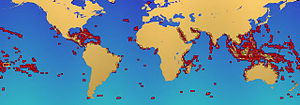
Our results suggest that severe reductions are likely to occur in coral reef diversity, structural complexity and resilience
Combining computer modeling with observations, an international team of scientists concluded that anthropogenic CO2 emissions over the last 100 to 200 years have already raised ocean acidity far beyond the range of natural variations. The study is published in the January 22 online issue of Nature Climate Change.
The team of climate modelers, marine conservationists, ocean chemists, biologists and ecologists, led by Tobias Friedrich and Axel Timmermann at the International Pacific Research Center, University of Hawaii at Manoa, came to their conclusions by using Earth system models that simulate climate and ocean conditions 21,000 years back in time, to the Last Glacial Maximum, and forward in time to the end of the 21st century. They studied in their models changes in the saturation level of aragonite (a form of calcium carbonate) typically used to measure of ocean acidification. As acidity of seawater rises, the saturation level of aragonite drops. Their models captured well the current observed seasonal and annual variations in this quantity in several key coral reef regions.
Today’s levels of aragonite saturation in these locations have already dropped five times below the pre-industrial range of natural variability. For example, if the yearly cycle in aragonite saturation varied between 4.7 and 4.8, it varies now between 4.2 and 4.3, which — based on another recent study — may translate into a decrease in overall calcification rates of corals and other aragonite shell-forming organisms by 15%. Given the continued human use of fossil fuels, the saturation levels will drop further, potentially reducing calcification rates of some marine organisms by more than 40% of their pre-industrial values within the next 90 years.
“Any significant drop below the minimum level of aragonite to which the organisms have been exposed to for thousands of years and have successfully adapted will very likely stress them and their associated ecosystems,” says lead author Postdoctoral Fellow Tobias Friedrich.
“In some regions, the man-made rate of change in ocean acidity since the Industrial Revolution is hundred times greater than the natural rate of change between the Last Glacial Maximum and pre-industrial times,” emphasizes Friedrich. “When Earth started to warm 17,000 years ago, terminating the last glacial period, atmospheric CO2 levels rose from 190 parts per million (ppm) to 280 ppm over 6,000 years. Marine ecosystems had ample time to adjust. Now, for a similar rise in CO2 concentration to the present level of 392 ppm, the adjustment time is reduced to only 100 — 200 years.”
Bookmark this page for “ocean acidity” and check back regularly as these articles update on a frequent basis. The view is set to “news”. Try clicking on “video” and “2” for more articles.







